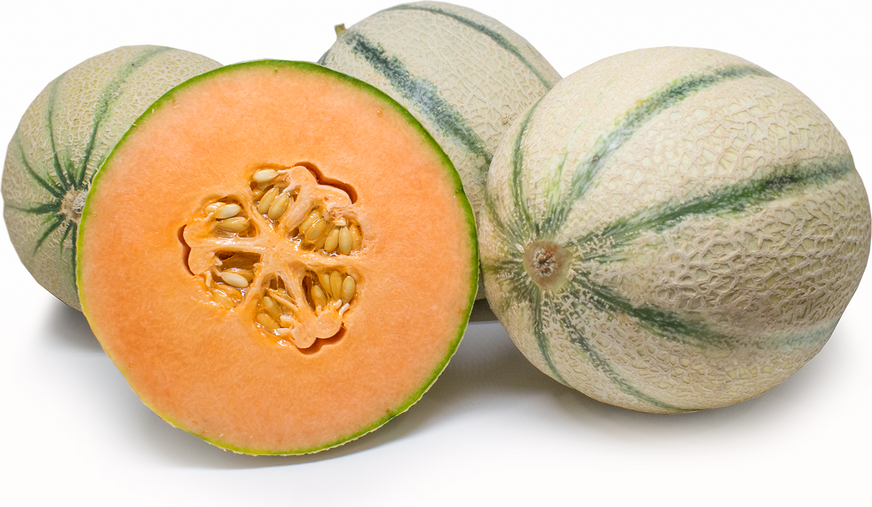


Magenta Melons
Estimated Inventory, Case : 0
Description/Taste
Magenta melons vary in size, but they are generally a medium to large varietal, averaging 1 to 2 kilograms in weight. The round to oval melons have a tough, hard rind, showcasing a tan to grey-green hue with dark green longitudinal sutured striping, covered in a uniform, raised, and textured netting. Underneath the rind, the flesh is thick, dense, and aqueous with a fleshy, smooth, and firm consistency. The flesh also exhibits a distinct dark red-orange, pigmented coloring, encasing a small central cavity filled with ivory to tan oval seeds suspended in fibers and gelatinous coatings. When ripe, Magenta melons emit a robust, sweet, fruity, and floral aroma. The flesh has a high sugar content, contributing to the melon’s very sweet, floral, and subtly fruity flavor with a pleasant, lingering aftertaste.
Seasons/Availability
Magenta melons are grown in the southern and northern hemispheres, providing year-round availability.
Current Facts
Magenta melons, botanically classified as Cucumis melo var. cantalupensis, are a specialty type of European cantaloupe belonging to the Cucurbitaceae family. The melons typically ripen in the mid to late season and are ready for harvest approximately 95 days after transplanting. Magenta melons are an F1 hybrid selected for commercial cultivation for their extended storage life, durability in shipping and handling, and unique flesh coloring. The melons were named for their pigmented flesh, showcasing a blend of vibrant red, orange, and salmon tones, and the flesh is aromatic and sweet, utilized in a wide array of culinary preparations. Magenta melons are prevalent throughout Europe as a fresh-eating variety known for its compact nature and full-bodied flavor. The melons are also cultivated and offered worldwide, as it is estimated that over 100,000 tons of Magenta melons are sold each year.
Nutritional Value
Magenta melons are a source of vitamin C to strengthen the immune system, beta-carotene, the orange pigment found in the melon’s flesh that provides antioxidant-like properties to protect the cells from free radical damage, and B vitamins to convert food into energy. The melons also provide fiber to regulate the digestive tract, potassium to balance fluid levels within the body, and lower amounts of copper, magnesium, iron, folate, niacin, zinc, calcium, and thiamine.
Applications
Magenta melons are sweet, juicy, and floral, showcased when served fresh. The melon’s rind should be scrubbed and washed with soap and water to remove harmful bacteria, and once cleaned, the melon can be sliced into wedges, cubes, and pieces. The seeds are also removed from the center cavity and can be cleaned, roasted, and dried as a crunchy snack. Magenta melons are consumed straight out of hand, or they can be sliced into salads, mixed into fruit bowls, or incorporated into breakfast dishes such as oatmeal, cereal, ricotta cheese, or yogurt. The flesh can also be pureed into smoothies and shakes, used to flavor cocktails, or blended into sorbet. The melon’s sweet nature complements the saltiness of cured meats and mixes with coconut broth as a chilled, savory-sweet soup. The melons are not traditionally cooked, but some chefs simmer the melons with sugar to create a marmalade or lightly grill the surface for a rich, deep flavor. Grilled Magenta melons can be drizzled in a syrup infused with fresh herbs as a bright and rich side dish. Magenta melons pair well with herbs such as mint, basil, rosemary, and cilantro, nuts including almonds, pistachios, walnuts, and hazelnuts, honey, maple syrup, vanilla, chocolate, citrus, and cheeses such as goat, feta, and ricotta. Magenta melons should be stored at room temperature, away from direct sunlight, until ripe. Once the melons are fragrant and mature, they become highly perishable and will keep 2 to 4 days when stored in the refrigerator. Slices of flesh will last up to three days in a sealed container in the fridge.
Ethnic/Cultural Info
Since its release, the name Magenta has transformed from a single variety to a line of pigmented red-orange-fleshed melons grown by Nunhems. The Magenta melon line consists of various specialty melons known as Magritte, Magnat, Magisto, Magestium, and Magenta. The newest melon within the Magenta line, known as Magverik or NUN 19058, was revealed in 2021 at the company’s annual Melon and Watermelon Business Trends event, hosted at their R&D center in Cartagena, Spain. Magverik melons are cultivated in Almería, a city in Andalusia, Spain, and are favored by growers for their ability to remain on the vine for extended periods and their pest resistance. Magverik melons are a mid-season variety, filling the need for an earlier ripening cultivar, as the other Magenta melon varieties typically mature in the late season. The Magenta melon line is bred to be a dual-purpose line, producing melons that can be used for fresh sales and processing.
Geography/History
Magenta melons were developed in the 20th century by Nunhems, an international seed company. Nunhems focuses on seed research and innovation, creating hybrid seeds to promote business growth, consumer satisfaction, and company profitability. The company also operates BASF, a seed sector under the Nunhems brand that researches and releases new varieties for improved agriculture. The history of Magenta melons is mostly unknown, but some experts believe the variety is a type of European cantaloupe. Magenta melons are grown in both hemispheres for year-round production and can be sown in open fields or greenhouses. They are typically planted in the Mediterranean, Southern Europe, Morocco, and other regions worldwide with a Mediterranean-like climate. Magenta melons were introduced into American markets in 2008 and were first promoted at the United Fresh exhibition in Las Vegas. Today Magenta melons are mostly sold throughout Europe and are found through select retailers, seed catalogs, grocers, and distributors.




